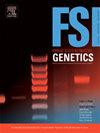揭示阿尔卑斯山瓦尔泽迁徙的遗传特征:多样性和分化模式。
IF 3.1
2区 医学
Q2 GENETICS & HEREDITY
引用次数: 0
摘要
自从离开非洲以来,人类经历了一系列的范围扩张。虽然这些扩张的基因组特征在大陆范围内可以很好地检测到,但在较短时间跨度内小规模扩张的基因组后果更难以解开。中世纪瓦尔泽人从瑞士南部(上瓦莱州)的家乡迁移到阿尔卑斯山脉的其他地区,这是人类相对较近的地理和人口扩张的一个很好的例子。虽然从20世纪80年代开始的几项研究,基于同工酶标记,评估了个体瓦尔瑟群落的隔离和近交水平,但它们大多是一次只关注一个群落。在这里,我们提供了遗传多样性和分化的综合概述,基于多个沃尔瑟人,沃尔瑟人家园,和非沃尔瑟高山群落的样本,以及一个理想的(模拟的)瑞士参考群体(Ref-Pop)。为了探索Walser迁徙在其后代基因组中的遗传信号,我们使用了一组法医常染色体str以及单亲标记。基于常染色体str的成对FST估计显示,与非Walser高山群落和理想的Ref-Pop相比,Walser-homeland和Walser群落表现出低至中等的遗传分化。地理上更偏远、可能更孤立的Lötschental Walser-homeland群落和Vals和Gressoney的Walser群落在遗传上比其他群落表现出更强的分化。对线粒体DNA的分析显示,在瓦尔泽人群落中存在W6单倍群,这是中欧罕见的单倍群。我们的研究有助于了解瓦尔瑟人故土和瓦尔瑟人的遗传多样性,但也强调了利用全基因组数据对欧洲阿尔卑斯人群遗传结构和进化史进行更全面研究的必要性。本文章由计算机程序翻译,如有差异,请以英文原文为准。
Uncovering genetic signatures of the Walser migration in the Alps: Patterns of diversity and differentiation
Since leaving Africa, human populations have gone through a series of range expansions. While the genomic signatures of these expansions are well detectable on a continental scale, the genomic consequences of small-scale expansions over shorter time spans are more challenging to disentangle. The medieval migration of the Walser people from their homeland in ssouthern Switzerland (Upper Valais) into other regions of the Alps is a good example of such a comparatively recent geographic and demographic expansion in humans. While several studies from the 1980s, based on allozyme markers, assessed levels of isolation and inbreeding in individual Walser communities, they mostly did so by focusing on a single community at a time. Here, we provide a comprehensive overview of genetic diversity and differentiation based on samples from multiple Walser, Walser-homeland, and non-Walser Alpine communities, along with an idealized (simulated) Swiss reference population (Ref-Pop). To explore genetic signals of the Walser migration in the genomes of their descendants, we use a set of forensic autosomal STRs as well as uniparental markers. Estimates of pairwise FST based on autosomal STRs reveal that the Walser-homeland and Walser communities show low to moderate genetic differentiation from the non-Walser Alpine communities and the idealized Ref-Pop. The geographically more remote and likely more isolated Walser-homeland community of Lötschental and the Walser communities of Vals and Gressoney appear genetically more strongly differentiated than other communities. Analyses of mitochondrial DNA revealed the presence of haplogroup W6 among the Walser communities, a haplogroup that is otherwise rare in central Europe. Our study contributes to the understanding of genetic diversity in the Walser-homeland and Walser people, but also highlights the need for a more comprehensive study of the population genetic structure and evolutionary history of European Alpine populations using genome-wide data.
求助全文
通过发布文献求助,成功后即可免费获取论文全文。
去求助
来源期刊
CiteScore
7.50
自引率
32.30%
发文量
132
审稿时长
11.3 weeks
期刊介绍:
Forensic Science International: Genetics is the premier journal in the field of Forensic Genetics. This branch of Forensic Science can be defined as the application of genetics to human and non-human material (in the sense of a science with the purpose of studying inherited characteristics for the analysis of inter- and intra-specific variations in populations) for the resolution of legal conflicts.
The scope of the journal includes:
Forensic applications of human polymorphism.
Testing of paternity and other family relationships, immigration cases, typing of biological stains and tissues from criminal casework, identification of human remains by DNA testing methodologies.
Description of human polymorphisms of forensic interest, with special interest in DNA polymorphisms.
Autosomal DNA polymorphisms, mini- and microsatellites (or short tandem repeats, STRs), single nucleotide polymorphisms (SNPs), X and Y chromosome polymorphisms, mtDNA polymorphisms, and any other type of DNA variation with potential forensic applications.
Non-human DNA polymorphisms for crime scene investigation.
Population genetics of human polymorphisms of forensic interest.
Population data, especially from DNA polymorphisms of interest for the solution of forensic problems.
DNA typing methodologies and strategies.
Biostatistical methods in forensic genetics.
Evaluation of DNA evidence in forensic problems (such as paternity or immigration cases, criminal casework, identification), classical and new statistical approaches.
Standards in forensic genetics.
Recommendations of regulatory bodies concerning methods, markers, interpretation or strategies or proposals for procedural or technical standards.
Quality control.
Quality control and quality assurance strategies, proficiency testing for DNA typing methodologies.
Criminal DNA databases.
Technical, legal and statistical issues.
General ethical and legal issues related to forensic genetics.

 求助内容:
求助内容: 应助结果提醒方式:
应助结果提醒方式:


